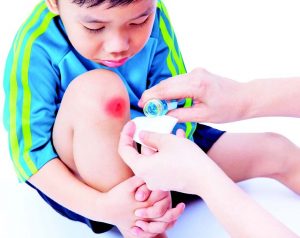Tetanus is a disease humans can pick up from animals, yet it isn’t as well known as rabies. Animal Scene presents you with more useful information on this dangerous and potentially deadly disease. Tetanus may be a serious disease for pet owners and pets alike, but with a little environmental management and medical preparation, we can minimize the chances of tetanus infection happening to our beloved fur babies or us.
Can Animals Be Infected with Tetanus?
We know they can carry and transmit the disease so this may come as a surprise, but animals—specifically, dogs and cats—can be affected by tetanus.
As with humans, the main sources of infection are puncture wounds, bites, and clawing wounds. If your pet has been involved in a brawl with other pets or animals, you should be on the lookout for the symptoms of tetanus as they apply to your pet.
It should be noted that cats and dogs are usually very resistant to tetanus, so there are supposedly no official vaccination shots for cats and dogs. Some vaccinations for horses can be used for dogs, but the effectivity of such for cats and dogs seems to be a matter up for debate even among veterinarians. It’s best to consult with your own vet.
The incubation period for tetanus in pets usually run from a few days to a few weeks, and it varies with the type of cat or dog (including what breed they are).
Tetanus in Cats

Tetanus is extremely rare in cats, as they are generally very resistant to tetanus. But they can still be affected. In their case, the effects of tetanus are usually localized, resulting in general stiffness and spasms in the local area of the wound.
The danger, however, is if the tetanus infection or poisoning spreads to the nervous system, in which case the following symptoms will be present:
- The cat’s mouth remains partially open, with the lips drawn back, the feline version of lockjaw.
- Exaggerated and violent muscle spasms when surprised or touched
- The cat has a hard time bending joints, walking, backing up or turning erect ears
- Tail is unusually stiff and erect
- Rapid breathing and heart rate
Sadly, the warm Philippine climate makes cats more susceptible to tetanus infection. As with humans, the sooner you can get your cat to a veterinarian, the better your cat’s outlook will be for recovery.
The following are part of tetanus treatment in cats:
- Wound cleaning – the wound may be repeatedly cleaned and drained as necessary
- Muscle relaxants, tranquilizers, or sedatives may be prescribed to ease the muscle spasms
- Antibiotics may be given to prevent the growth of the tetanus bacteria
- Tetanus antitoxin, separate from the antibiotics, may be given to combat the poisons that the bacteria manufactures
It is normal for a veterinarian to keep your pet in the clinic for observation, to see how well your cat is responding to the treatments.
Tetanus in Dogs

Dogs are not as resistant to tetanus as cats are, but they are still more resistant to it than humans are. That said, the following are symptoms of tetanus in dogs. It should be noted that dogs, unlike cats, seem to get the generalized version of tetanus, rather than the localized version.
- Neck and jaw muscles become stiff
- Their legs are rigid when they are standing
- Muscle spasms
- Pain reaction when touched
- Stiff tail
- Drooling
- Unusual or abnormal facial expressions
- Swollen face
- Fever
- Difficulty breathing and eating
- Dehydration
- Constipation
Tetanus treatment for dogs is more involving than it is for cats, with the following:
- Rehydration
- Oxygen therapy
- Muscle relaxants, tranquilizers, or sedatives may be prescribed to ease the muscle spasms
- Antibiotics may be given to prevent the growth of the tetanus bacteria
- Tetanus antitoxin, separate from the antibiotics, may be given to combat the poisons that the bacteria manufactures
Although your pet dog may be taken home after a few days in clinical care, it’s suggested that you let them stay in a quiet, dark area. You will also have to observe.
Prevention
Although tetanus is a serious disease, the general prevention for tetanus is quite simple:
KEEP THINGS CLEAN. That means that as much as possible, your surroundings, particularly those that you and your pet interact with, are kept as clean as possible. Obviously, this doesn’t work as well if you have an area with soil and dirt, such as a garden, but making sure that all other areas are clean makes for a minimized risk for tetanus infection.
For your pets, you should also do the following:
- Regular baths
- Keep their claws trimmed
- Keep their pet areas clean – this includes cages and enclosed areas, if they have any
- Toys, favorite items such as old shirts and pet pillows, should also be regularly cleaned
- Food bowls and water dispensers should be regularly cleaned as well
- Toilet train your pets, and at the same time clean up urine or feces around the house immediately
- If your pet has a habit of eating feces, address it immediately
- Do not leave “chewable” target objects around the house if your dog has teething issues, or regularly chews on objects as a sign of stress
Human Tips: TREATMENT

-
If You Have Been Wounded
If you suspect your pet has tetanus and you aren’t sure that you have completed the proper set of vaccination injections, then your doctor will most probably give you an injection of tetanus immunoglobulin. If you were bitten by an unfamiliar dog or cat, then this is usually included along with the vaccination against rabies. This injection will boost your immunity against tetanus for the short term. Your doctor will also thoroughly clean the wound.
Cleaning the Wound
- If you haven’t gone to a doctor yet, do make sure to inspect the wound, be it a bite or clawing wound. You should first put the wound under clean running water, and then, if possible, disinfect it. For shallow wounds, this can be done with soap and water. After that, you can apply pressure and clean bandages to the wound until the bleeding stops.
- However, if the wound is noticeably deep, looks like a deep puncture or bite mark, or refuses to stop bleeding, then you should immediately go to an emergency room or local clinic. This is particularly important if the wound is located on the face, neck, hand, feet, or near a joint.
- Even if the bleeding has stopped, if the wound feels red, warm, swollen, or painful over the next few hours or days, then you should seek medical help as soon as possible.
- Do note that children who have been recently sick and the elderly may have weakened immune systems, so a bite or clawing wound may be dangerous for them.
- You should also observe your pet for any untoward characteristics, aside from rabies, animals themselves could also be affected by tetanus, or have been infected by tetanus from the same source as what can infect the bite or clawing victim.
-
If You are Developing Symptoms
If you are already developing symptoms of tetanus, you should head to the ER immediately. Aside from the tetanus immunoglobulin injection, doctors will also use antibiotics and medicines to help you with muscle stiffness and spasms.
It should be noted that the fatality rate is low for the general version of tetanus, and that proper medical treatment will have you up and about in a few months.
-
If you are traveling or Working with Animals
If you will be traveling to places where there are wild animals, or if you will take on a job that involves animals, it is always important to make sure that you are properly vaccinated against tetanus. In addition, even if you are properly vaccinated, do make sure to present your vaccination history to a doctor if you have experienced a cut or wound that you think may be risky for tetanus.
This appeared in Animal Scene magazine’s February 2018 issue.






